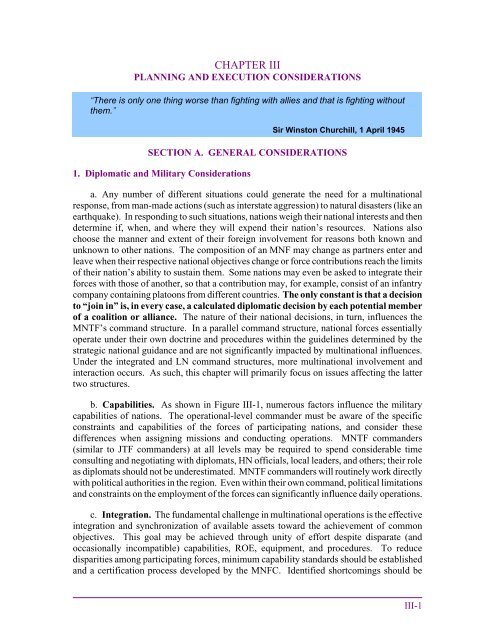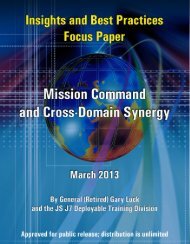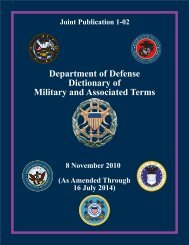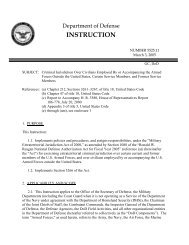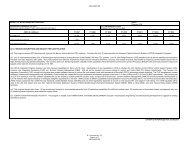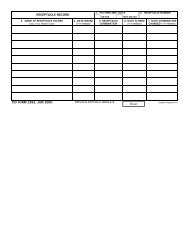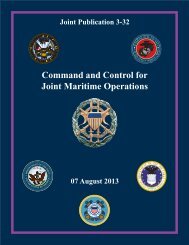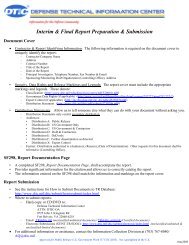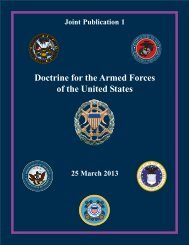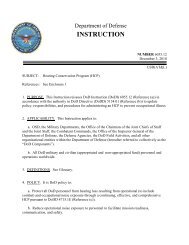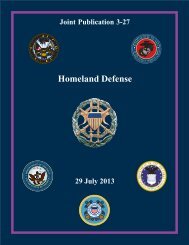JP 3-16, Multinational Operations - Defense Technical Information ...
JP 3-16, Multinational Operations - Defense Technical Information ...
JP 3-16, Multinational Operations - Defense Technical Information ...
You also want an ePaper? Increase the reach of your titles
YUMPU automatically turns print PDFs into web optimized ePapers that Google loves.
CHAPTER III<br />
PLANNING AND EXECUTION CONSIDERATIONS<br />
“There is only one thing worse than fighting with allies and that is fighting without<br />
them.”<br />
SECTION A. GENERAL CONSIDERATIONS<br />
1. Diplomatic and Military Considerations<br />
Sir Winston Churchill, 1 April 1945<br />
a. Any number of different situations could generate the need for a multinational<br />
response, from man-made actions (such as interstate aggression) to natural disasters (like an<br />
earthquake). In responding to such situations, nations weigh their national interests and then<br />
determine if, when, and where they will expend their nation’s resources. Nations also<br />
choose the manner and extent of their foreign involvement for reasons both known and<br />
unknown to other nations. The composition of an MNF may change as partners enter and<br />
leave when their respective national objectives change or force contributions reach the limits<br />
of their nation’s ability to sustain them. Some nations may even be asked to integrate their<br />
forces with those of another, so that a contribution may, for example, consist of an infantry<br />
company containing platoons from different countries. The only constant is that a decision<br />
to “join in” is, in every case, a calculated diplomatic decision by each potential member<br />
of a coalition or alliance. The nature of their national decisions, in turn, influences the<br />
MNTF’s command structure. In a parallel command structure, national forces essentially<br />
operate under their own doctrine and procedures within the guidelines determined by the<br />
strategic national guidance and are not significantly impacted by multinational influences.<br />
Under the integrated and LN command structures, more multinational involvement and<br />
interaction occurs. As such, this chapter will primarily focus on issues affecting the latter<br />
two structures.<br />
b. Capabilities. As shown in Figure III-1, numerous factors influence the military<br />
capabilities of nations. The operational-level commander must be aware of the specific<br />
constraints and capabilities of the forces of participating nations, and consider these<br />
differences when assigning missions and conducting operations. MNTF commanders<br />
(similar to JTF commanders) at all levels may be required to spend considerable time<br />
consulting and negotiating with diplomats, HN officials, local leaders, and others; their role<br />
as diplomats should not be underestimated. MNTF commanders will routinely work directly<br />
with political authorities in the region. Even within their own command, political limitations<br />
and constraints on the employment of the forces can significantly influence daily operations.<br />
c. Integration. The fundamental challenge in multinational operations is the effective<br />
integration and synchronization of available assets toward the achievement of common<br />
objectives. This goal may be achieved through unity of effort despite disparate (and<br />
occasionally incompatible) capabilities, ROE, equipment, and procedures. To reduce<br />
disparities among participating forces, minimum capability standards should be established<br />
and a certification process developed by the MNFC. Identified shortcomings should be<br />
III-1


